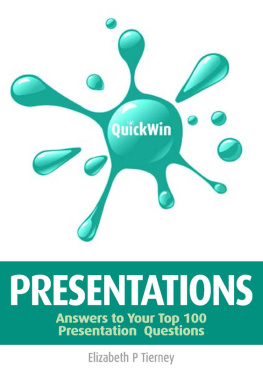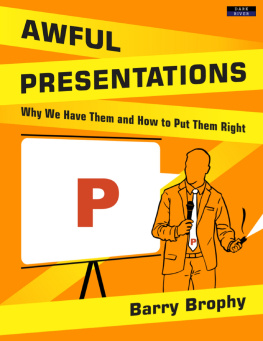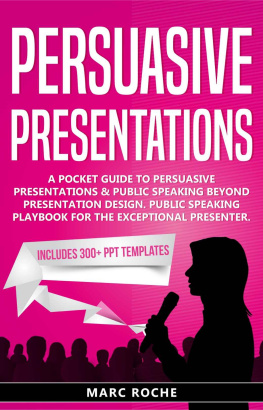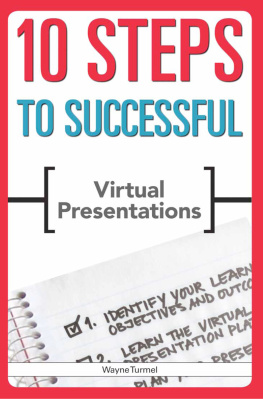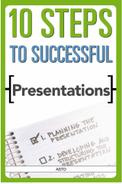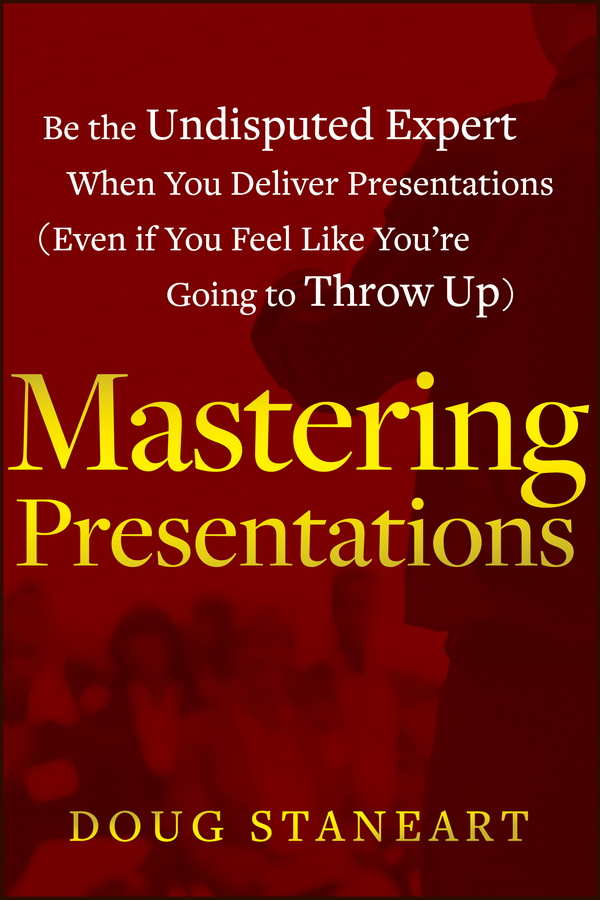Contents

Cover image: Seminar @ Joshua Hodge Photography/istockphoto
Cover design: John Wiley & Sons, Inc.
Copyright 2013 by Doug Staneart. All rights reserved.
Published by John Wiley & Sons, Inc., Hoboken, New Jersey.
Published simultaneously in Canada.
No part of this publication may be reproduced, stored in a retrieval system, or transmitted in any form or by any means, electronic, mechanical, photocopying, recording, scanning, or otherwise, except as permitted under Section 107 or 108 of the 1976 United States Copyright Act, without either the prior written permission of the Publisher, or authorization through payment of the appropriate per-copy fee to the Copyright Clearance Center, 222 Rosewood Drive, Danvers, MA 01923, (978) 750-8400, fax (978) 646-8600, or on the web at www.copyright.com . Requests to the Publisher for permission should be addressed to the Permissions Department, John Wiley & Sons, Inc., 111 River Street, Hoboken, NJ 07030, (201) 748-6011, fax (201) 748-6008, or online at http://www.wiley.com/go/permissions .
Limit of Liability/Disclaimer of Warranty: While the publisher and author have used their best efforts in preparing this book, they make no representations or warranties with the respect to the accuracy or completeness of the contents of this book and specifically disclaim any implied warranties of merchantability or fitness for a particular purpose. No warranty may be created or extended by sales representatives or written sales materials. The advice and strategies contained herein may not be suitable for your situation. You should consult with a professional where appropriate. Neither the publisher nor the author shall be liable for damages arising herefrom.
For general information about our other products and services, please contact our Customer Care Department within the United States at (800) 762-2974, outside the United States at (317) 572-3993 or fax (317) 572-4002.
Wiley publishes in a variety of print and electronic formats and by print-on-demand. Some material included with standard print versions of this book may not be included in e-books or in print-on-demand. If this book refers to media such as a CD or DVD that is not included in the version you purchased, you may download this material at http://booksupport.wiley.com . For more information about Wiley products, visit www.wiley.com .
Library of Congress Cataloging-in-Publication Data :
Staneart, Doug, 1971
Mastering presentations : be the undisputed expert when you deliver presentations (even if you feel like youre going to throw up) / Doug Staneart.
p. cm.
Includes index.
ISBN 978-1-118-48430-2 (pbk.); ISBN 978-1-118-49416-5 (ebk); ISBN 978-1-118-49426-4 (ebk); ISBN 978-1-118-49428-8 (ebk)
1. Business presentations. 2. Public speaking. I. Title.
HF5718.22.S738 2013
658.452dc23 2012030205
To the more than 12,000 Fearless Presentation graduates
who were my lab class for the concepts in this book .
Thanks, everyone!
Introduction: Why This Book Was Written
Just about everything that you have ever learned about public speaking is wrong!
Doug Staneart
When I gave my first business presentation, I was absolutely terrified.
I was just a few months away from graduating from college, and I was an intern for a huge oil company at a time when the price of oil had plummeted to about $16 per barrel. We were told that in earlier years that as long as an intern did a good job while working for the company, the company almost always extended an invitation for a full-time position upon graduation. However, I was in the acquisitions and divestitures (A&D) department of the company during the internship, and for the entire time that I was there, we never acquired any oil properties or oil interests. We were selling everything. As we did, more of the full-time employees were being laid off and being hired back as temporary contract workers.
I could see the handwriting on the wall, so I called the director who was in charge of the intern program and asked her what the real prospects were of me actually having a job when I graduated. She paused for a good 4 or 5 seconds before answering the question. She said, Doug, my understanding is that, in this economy, we are probably only likely to permanently hire, at most, 4 of the 20 interns. In fact, I just found out that the company is discontinuing the intern program for at least one year.
Are you out of a job? I asked her.
No, it is not quite that bad yet. The company is moving me to Bakersfield. It is a lateral move, but they are taking care of me. By the way, youve got a good shot at getting one of the permanent positions, because of your experience in A&D. Just do well in your exit presentation, because some of the vice presidents have been impressed with your work so far. I knew what she really meant, though; I had a good shot at getting hired because Id work for a salary that was about a third the size of the employees who were getting laid off.
At that point in my life, I had been told that to be successful, I had to go to school, get a good job, work my way up the corporate ladder, and become chief executive officer (CEO) by the time I was 34. Now what I saw was my entire future at stake, and this particular future depended almost entirely on a single 15-minute presentation. No pressure, right?
In school, I had always been a decent speaker. My presentations were nothing to write home about, but I muddled through them as I advanced from one grade to the next. I had also been an elected officer in a couple of clubs, so I didnt feel like I needed a lot of help presenting. However, the semester before I started the internship, I took a class called Business Communications. My entire grade that semester was determined by three presentations that I delivered about three or four weeks apart. On the first presentation, the graduate student who was teaching the class gave me a 94 percent which was an A. Immediately after the presentation, she gave me a pretty fair critique. She complimented me on my content and delivery, but she gave me a couple of items to work on before the next presentation. She told me that I said uhm seven times in the presentation and that it was a distraction. She also told me that when I stuck my right hand into my pocket, I looked nervous.
I spent the next three weeks working on saying uhm less and keeping my hand out of my pocket when I practiced. I said uhm 14 times during the second presentation, and I ended up getting an 84 percent. I didnt stick my hand in my pocket, but every time I caught myself almost sticking my hand in my pocket, I would stop abruptly, and I reacted in an odd way. I also knew that the teacher was counting off how often I said uhm , and it threw me.
When I delivered my third presentation, I focused very little time on the content and spent a lot of time on trying to fix what my teacher was telling me were problems. I ended up getting a 74 percent on the third presentation. I ended up with a B in the class, but I was just glad there wasnt a fourth presentation. When the class was over, for the first time in my life, I felt like a failure as a presenter. I got worse every time that I presented, so I assumed something was wrong with me.
About four months later, I was at the top of a skyscraper in downtown Dallas giving a presentation to all of my peers (the other interns who were competing against me for these four permanent positions), the head of the intern program, my boss, all of the other interns bosses, and three vice presidents from the home office.


